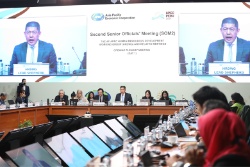Chances of El Niño event decreasing this summer
• Vava’u Mangrove Survey
successfully completed using GIS
• Chances of
El Niño event decreasing this summer
Vava'u Mangrove Survey successfully
completed using GIS
11 October 2012 - The
Vava'u Mangrove Survey which used Geographical Information
Systems (GIS) found the mangroves of the island of Vava'u,
Tonga in generally good condition.
This is according to Environmental Monitoring Analyst, Mr. Paul Anderson, of the Secretariat of the Pacific Regional Environment Programme (SPREP).
"Despite the usual impacts, of cutting, burning and waste the mangroves were in generally good condition, meaning the mangroves are resilient and healthy in most cases," he said.
Mangroves are vital to island ecosystems as they provide habitats for fish and crabs, protect coastlines and keep the water clean. Mangroves remain a major component of ecosystem-based adaptation to climate change.
Anderson was the lead trainer for the one week Vava'u Mangrove Survey, a project by SPREP in partnership with Mangrove Ecosystems for Climate Change Adaptation and Livelihoods (MESCAL) and Ministry of Lands Environment Climate Change and Natural Resources, Tonga. (MLECCNR).
"The project maps and assesses the conditions of the mangroves of Vavau and trains local staff and volunteers on mangrove monitoring methodology and technology," Anderson said.
The technology used during the
training included GIS, Geographical Positioning Systems
(GPS) and the Pacific Mangrove Monitoring Manual produced by
SPREP.
Vava'u currently hosts 30% of Tonga’s
mangroves, covering approximately 381 hectares of
land.
Anderson said: "As part of the training and survey,
we visited the majority of the sites, exploring first-hand
the condition of the mangroves, and assessing the impacts of
human activity and nature on the mangroves."
During the surveys, the team discovered a small leaf mangrove associate species, which was only recently discovered in Tongatapu Pemphis acidula.
"This was a significant find as it expands the range of this species to a new island group," said Mr Anderson.
In addition to the small leaf mangrove associate, the team also came across the largest recorded red mangrove in the Tongan islands measuring at 20cm in diameter.
The team installed permanent monitoring points to asses and monitor the condition of mangroves over time.
Anderson acknowledged the contribution of his MLECCNR counterpart Sione Tukia Latu, the assistance of the MLECCNR Vava'u and Tongatapu personnel and the support of the Vava’u Environmental Protection Association (VEPA) in the field monitoring and GIS work.
Chances of El
Niño event decreasing this summer
11 October
2012 - Heading into the southern hemisphere summer, signals
of an El Niño event in the Pacific Ocean are easing, and
near normal rainfall conditions are expected across the
Pacific.
Although the tropical Pacific Ocean is still warmer than normal east of the Dateline, it is less so than a month ago. Easterly wind patterns across the tropical Pacific have not shown any signs of weakening. A warmer than usual equatorial ocean and weaker trade winds than normal are typical signatures of an El Niño.
The chances of an El Niño this summer are decreasing, and if one does occur it will probably be weak and short-lived.
Rainfall along the equator in the central and eastern Pacific is expected to be slightly higher than normal, while slightly drier than normal conditions are forecast further south for a region extending from Papua New Guinea to the Southern Cook Islands.
Tonga and Niue have recently been on drought watches. While November is the start of the wet season for these two countries, over the next three months Tonga can expect a little less rain than usual for the start of the wet season and Niue can expect nearly normal rainfall.
Guidance on the upcoming tropical cyclone season will be issued later this month.
The Island Climate Update is produced by the Pacific Island Meteorological Services, NIWA and SPREP. Please contact your local meteorological service or see www.islandclimateupdate.net for more details.


 Being LBGTI in Asia: UNDP And ILGA World Launch The International Pride Awards, Recognising LGBTIQ+ Equality Champions
Being LBGTI in Asia: UNDP And ILGA World Launch The International Pride Awards, Recognising LGBTIQ+ Equality Champions UN News: UN Teams Dispatch Aid As Deadly Flash Floods Hit Northern Afghanistan
UN News: UN Teams Dispatch Aid As Deadly Flash Floods Hit Northern Afghanistan Save The Children: It’s Not Safe And It’s Not Clean, But People Believe They Are Leaving Something Worse Behind
Save The Children: It’s Not Safe And It’s Not Clean, But People Believe They Are Leaving Something Worse Behind APEC: APEC Commits To Empowering People With Disabilities
APEC: APEC Commits To Empowering People With Disabilities UN News: Israeli Forces Bringing War To The West Bank, Warns UN Rights Office
UN News: Israeli Forces Bringing War To The West Bank, Warns UN Rights Office UN News: 10,000 People Feared Buried Under The Rubble In Gaza
UN News: 10,000 People Feared Buried Under The Rubble In Gaza